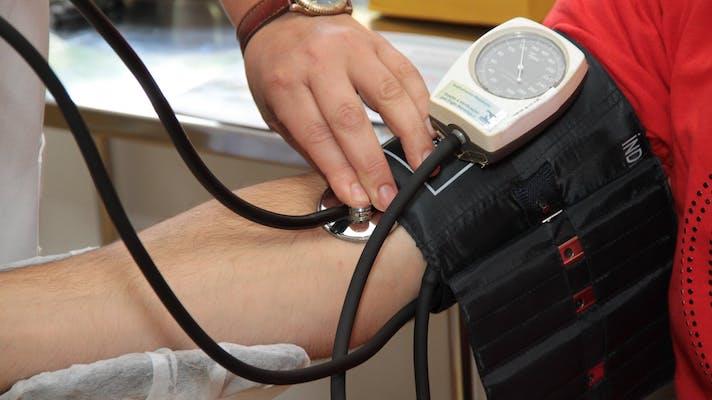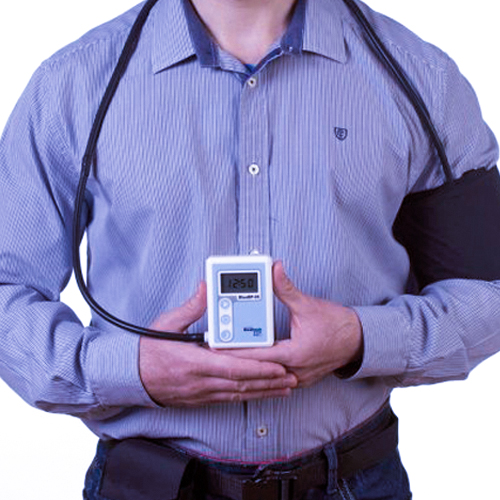The Benefits of the ABPM Test for Accurate Blood Pressure Evaluation
Ambulatory Blood Pressure Monitoring (ABPM) uses an innovative method to assessing high blood pressure. This method offers continuous, 24-hour information, catching changes that occur during everyday activities and rest. Such detailed monitoring not only enhances accuracy yet also exposes critical patterns, assisting to differentiate between true hypertension and conditions like white-coat syndrome. Understanding these nuances can cause extra reliable therapy methods. What ramifications might this have for patient care and management?
What Is Ambulatory Blood Pressure Monitoring (ABPM)?
Ambulatory Blood Pressure Monitoring (ABPM) is a technique that enables for constant blood stress analysis over a 24-hour period, offering an extensive photo of an individual's high blood pressure fluctuations. ABPM test in Bangalore. This strategy uses a mobile device that immediately determines high blood pressure at routine intervals throughout the day and evening. As individuals tackle their everyday tasks, the gadget captures information showing their blood pressure variants during various times and situations, consisting of sleep and physical exertion.ABPM is specifically valuable for detecting problems such as hypertension, as it can distinguish between true high blood pressure and white-coat syndrome, where clients exhibit elevated analyses in scientific settings but not in their daily lives. By providing an in-depth view of blood pressure modifications, ABPM help medical care providers in making educated decisions concerning medical diagnosis and treatment. Furthermore, it improves the understanding of high blood pressure patterns, allowing personalized monitoring methods for clients
Constant Monitoring for Improved Accuracy
Continuous monitoring of high blood pressure with ABPM substantially boosts the accuracy of analyses compared to traditional methods. This technique permits high blood pressure dimensions at routine periods throughout the night and day, catching fluctuations that might occur because of everyday tasks, stress and anxiety, or various other aspects. Unlike solitary readings taken during a clinic browse through, ABPM offers a detailed profile of a client's high blood pressure over a 24-hour period.This continuous assessment causes a lot more dependable information, enabling health care companies to determine patterns and potential problems that may go undetected with erratic measurements. It also helps distinguish in between real hypertension and white-coat syndrome, where clients exhibit elevated readings due to anxiety in a medical setting. By leveraging the benefits of constant monitoring, ABPM significantly boosts medical diagnosis and treatment strategies, inevitably adding to far better individual outcomes and more tailored health care strategies.
Comprehending Blood Pressure Irregularity
Blood pressure variability describes the variations in high blood pressure analyses that can occur with time as a result of different aspects, consisting of physical task, anxiety, and circadian rhythms. This irregularity is considerable as it provides understandings right into an individual's cardio health and wellness. ABPM test in Bangalore. As an example, factors such as exercise can temporarily raise high blood pressure, while relaxation might bring about a decrease. In addition, the body's natural rhythms can cause high blood pressure to differ throughout the day, generally being reduced at evening and higher during waking hours. High levels of variability have been related to enhanced risks of cardio occasions, making it vital for medical care professionals to keep track of these fluctuations. Recognizing blood stress irregularity helps in customizing treatment strategies and evaluating total health. Exact appraisal through approaches like Ambulatory High blood pressure Monitoring (ABPM) can catch these variations, enabling for an extra extensive exam of a patient's high blood pressure profile
Identifying White Coat Hypertension
White coat hypertension, usually referred to as white layer disorder, is characterized by raised high blood pressure readings in scientific settings due to stress and anxiety or tension. Identifying its signs and symptoms and indicators is important for accurate diagnosis, as misinterpretation can result in unnecessary therapies. Recognizing this phenomenon is essential for efficient blood pressure administration and person treatment.
Recognizing White Coat Syndrome
Although several people exhibit raised high blood pressure readings in scientific settings, this sensation, referred to as white coat high blood pressure, can cover truth state of their cardio health. This condition happens when people experience anxiousness or stress and anxiety throughout clinical check outs, causing short-lived spikes in blood stress. Because of this, doctor may misinterpret these analyses as a sign of high blood pressure. White layer disorder highlights the significance of exact blood pressure analysis, as depending entirely on in-office measurements can lead to unnecessary therapies or mistaken beliefs look at here about a client's health and wellness. Comprehending this syndrome is crucial for clinicians, as it highlights the need for alternate monitoring techniques, such as ambulatory blood stress monitoring (ABPM), to obtain an extra exact representation of a patient's high blood pressure levels.
Signs and symptoms and Indicators
Many individuals may experience certain symptoms that suggest the presence of white coat high blood pressure. These signs and symptoms can consist of raised high blood pressure analyses during clinical sees, gone along with by feelings of anxiousness or uneasiness in a professional environment. Clients commonly report a rapid heart beat or sweating when engaging with healthcare specialists, which might exacerbate their blood stress degrees. Furthermore, some people may discover a disparity between their in-office blood pressure readings and those taken at home, where they feel extra kicked back. Identifying these symptoms is necessary, as they can indicate that stress and anxiety or stress and anxiety pertaining to clinical settings is influencing their high blood pressure. Understanding these indicators can help in identifying white coat hypertension and determining the necessity for more analysis.

Value of Accurate Medical Diagnosis
Properly diagnosing white coat hypertension is essential for efficient blood pressure management. This condition takes place when a client displays raised high blood pressure analyses in a clinical setting due to anxiety or anxiety, while typical readings are taped in a much more unwinded setting. Misdiagnosis can bring about unneeded treatment, subjecting people to prospective medication adverse effects with no genuine health advantage. Making use of ambulatory blood stress monitoring (ABPM) is essential in distinguishing true hypertension from white layer disorder. ABPM supplies constant high blood pressure measurements over 24 hours, allowing for a detailed analysis that can aid healthcare suppliers make informed decisions. Inevitably, exact recognition of white coat high blood pressure warranties patients obtain proper care and stays clear of the risks of mismanagement.
Evaluating Nighttime Blood Pressure Patterns
Examining nocturnal high blood pressure patterns is crucial for recognizing an individual's total cardiovascular health. Nighttime measurements can reveal substantial variations in blood stress, which might suggest hypertension irregularity. Furthermore, these patterns are closely associated with heart health and wellness, highlighting the value of constant monitoring beyond conventional office visits.
Relevance of Nighttime Measurements

Nighttime high blood pressure measurements are usually essential for comprehending a person's overall cardio wellness. These readings give vital insights right into just how high blood pressure behaves throughout sleep, which can differ considerably from daytime degrees. Keeping track of nocturnal blood stress enables the recognition of uncommon patterns, such as non-dipping or reverse-dipping phenomena, which might indicate a boosted risk for cardiovascular events. Furthermore, nighttime assessments can aid evaluate the effectiveness of antihypertensive therapies, ensuring that medicines are suitably managed. By catching high blood pressure changes throughout the night, medical care specialists can create a lot more individualized therapy strategies, ultimately enhancing person results and decreasing the possibility of long-term complications connected with hypertension. This highlights the relevance of thorough high blood pressure examination throughout the night and day.
Spotting Hypertension Variability
Just how can the variability of nocturnal high blood pressure patterns educate high blood pressure administration? The analysis of nighttime high blood pressure with the Ambulatory Blood Pressure Monitoring (ABPM) examination reveals important fluctuations that usually go unnoticed in traditional measurements. These patterns can suggest the presence of "non-dipping" hypertension, where high blood pressure stops working to drop during rest, suggesting an enhanced cardio danger. By determining such variability, medical care providers can tailor interventions extra efficiently, changing therapy plans based on the patient's details nocturnal blood pressure habits. Comprehending these patterns likewise help in assessing the effectiveness of antihypertensive medicines, making sure that clients attain suitable high blood pressure control throughout the night and day. Nocturnal evaluation ends up being crucial in extensive hypertension management.
Relationship With Heart Wellness
Comprehending nighttime high blood pressure patterns not only aids in hypertension management yet likewise has substantial ramifications for heart health and wellness. Research indicates that unusual nocturnal high blood pressure analyses, such as non-dipping or reverse dipping patterns, are associated with boosted cardiovascular threats. Throughout sleep, blood pressure normally declines, a sensation crucial for cardiovascular recovery. When this decline is absent, it may signal underlying problems such as autonomic disorder or increased arterial tightness. In addition, individuals with elevated nighttime high blood pressure go to an enhanced risk for heart assault and stroke. Consequently, using ambulatory high blood pressure monitoring (ABPM) to evaluate these nighttime patterns can offer important insights, enabling tailored interventions that much better protect heart wellness and boost total individual end results.
Tailoring Treatment Plans Based Upon Real-Life Information
Tailoring treatment strategies based on real-life data includes leveraging constant high blood pressure keeping track of to create personalized medical care methods. The Ambulatory Blood Pressure Monitoring (ABPM) test supplies a thorough profile of a client's blood pressure variations throughout everyday tasks. This detailed information allows medical care service providers to recognize patterns that could be ignored in typical workplace visits.By assessing variations in high blood pressure throughout various times and conditions, clinicians can change medications, dosages, and way of life referrals to far better fit specific patient needs. This tailored approach not just improves the performance of treatment plans however additionally minimizes the possibility of adverse reactions to medications.Furthermore, real-life information can disclose prospective triggers for hypertension, leading to positive treatments. Generally, customizing treatment based on continuous monitoring promotes a more effective, address patient-centered approach to taking care of hypertension and great post to read enhancing long-lasting wellness end results.
Boosted Client Compliance and Engagement
While conventional monitoring approaches might restrict client involvement, using Ambulatory High blood pressure Monitoring (ABPM) greatly enhances individual conformity and interaction in their own medical care. By allowing people to wear a portable gadget that tape-records high blood pressure over 24 hours, ABPM empowers people to take an energetic duty in their health administration. This continual monitoring supplies an extra extensive sight of blood stress variations, motivating individuals to recognize their condition better.Moreover, ABPM promotes a setting where patients can discuss their readings with health care service providers a lot more meaningfully, causing informed decision-making. Clients end up being much more bought adhering to recommended treatments and lifestyle modifications when they see real-time data mirroring their health and wellness standing. The shift from easy participant to energetic collaborator not just boosts compliance but also enhances total health and wellness outcomes, making ABPM an important tool in promoting person involvement in hypertension monitoring.
Frequently Asked Inquiries
The length of time Does an ABPM Examination Typically Last?
The ABPM examination normally lasts 24 hours. During this duration, it measures high blood pressure at routine periods, providing a detailed analysis of an individual's high blood pressure patterns throughout their daily activities and rest.
Are There Any Kind Of Risks Connected With ABPM Testing?

Can ABPM Be Used for Children and Teenagers?
ABPM can be utilized for children and adolescents, providing crucial understandings into their blood pressure patterns. Correct devices sizing and analysis by experienced experts are crucial to assure exact evaluations and prevent misdiagnosis.
How Is ABPM Different From Traditional Blood Pressure Monitoring?
ABPM varies from traditional monitoring by giving continuous blood stress analyses over 1 day, recording variants during day-to-day tasks and rest, whereas standard approaches frequently count on single measurements, potentially missing out on essential fluctuations in blood stress.
What Should Individuals Do Throughout the ABPM Examination?
During the ABPM test, individuals ought to keep normal tasks while preventing heavy workout, extreme caffeine, and smoking cigarettes. They must likewise keep their arm still when the tool inflates, making certain exact analyses throughout the monitoring period.